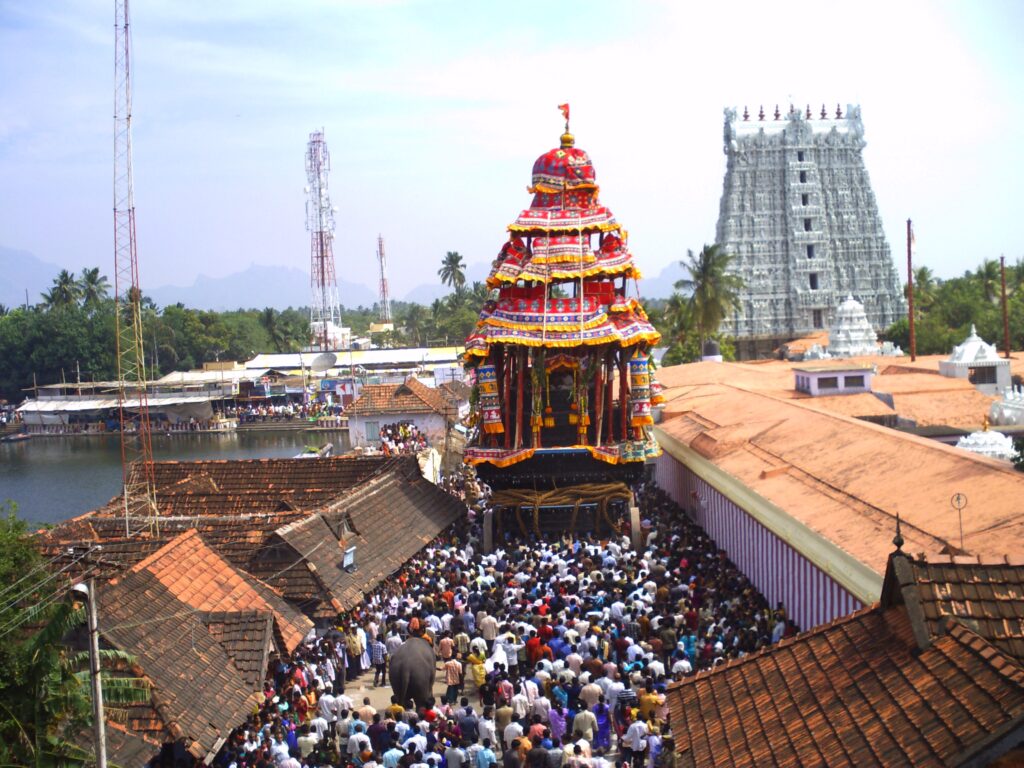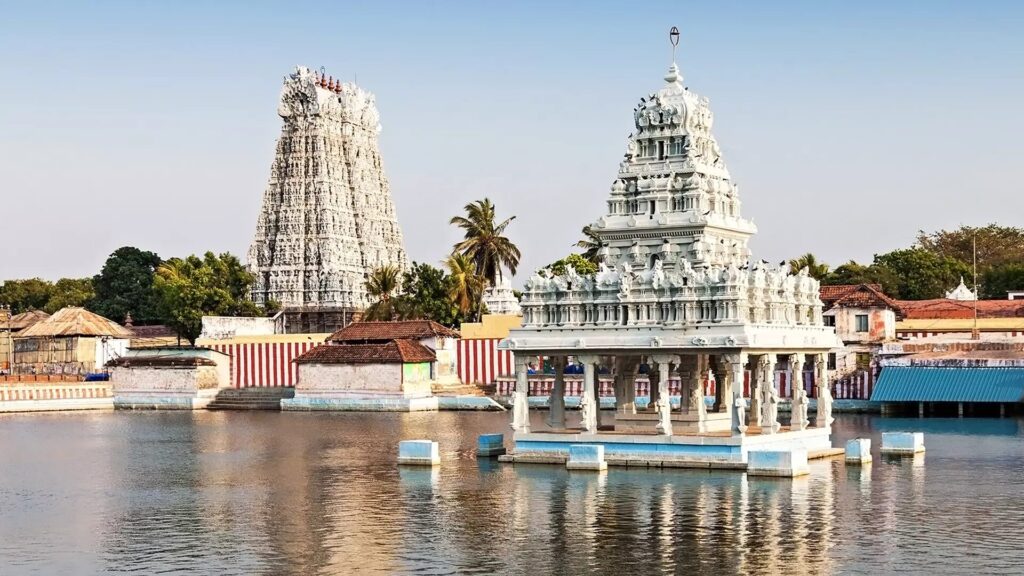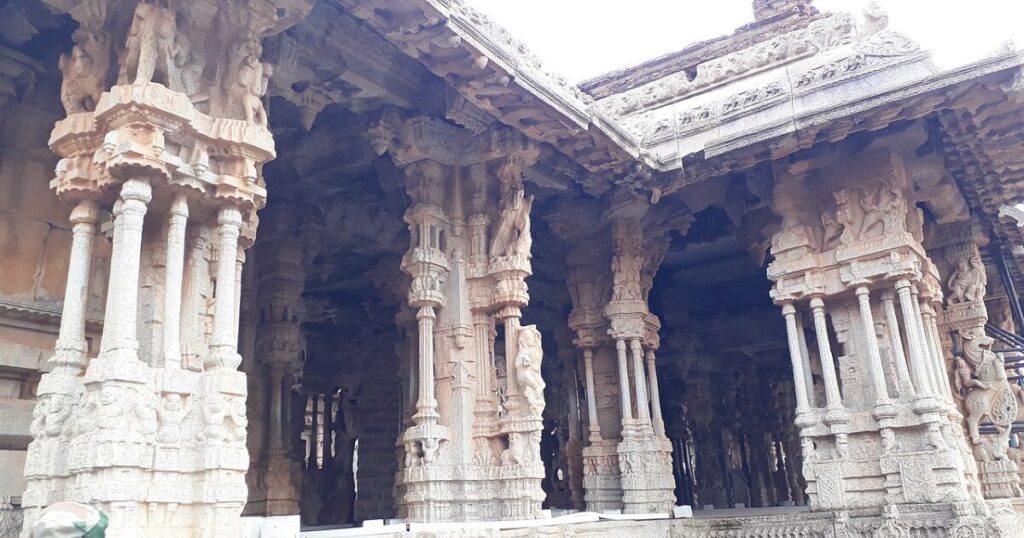Introduction – The Thanumalayan Temple, also known as Sthanumalayan Temple or Suchindram Temple, is situated in the town of Suchindram in Tamil Nadu’s Kanyakumari district. This sacred site is adored by both Shaivaite and Vaishnavite sects of Hinduism, embodying the spiritual unity of diverse traditions.
Divine Origins – According to Hindu legend, Indra, the king of the Devas, was freed from a curse at the site where the main Linga of the Thanumalayan Temple now stands. The name “Suchi” in Suchindram is said to derive from the Sanskrit word for “purify,” signifying the purification Indra underwent. It is believed that Indra visits the temple daily to perform the sacred Ardhajama Pooja (midnight worship). Mythology also links the temple to Sage Atri and Anasuya, whose unparalleled devotion inspired the Hindu trinity—Brahma, Vishnu, and Shiva—to manifest as three Lingams, solidifying the temple’s divine significance.
Historical Evolution – The temple’s rich history spans the Chola, Pandya, and Chera dynasties, with inscriptions from Parantaka I’s reign (907–950 CE). Renovated in the 17th century, the temple flourished under Travancore Maharajas, with notable innovations like the 1875 lottery system by Ayilyam Thirunal Rama Varma Maharajah, which raised funds for temple restoration.
Sacred Symbolism and Cultural Legacy – The name “Sthanumalayan” represents the Trimurti, with Sthanu symbolizing Lord Shiva, Mal representing Lord Vishnu, and Ayan denoting Lord Brahma. This temple is unique as it is among the Abhimana Kshetrams in Vaishnavite traditions. Historically, the Thanumalayan Temple has held great significance in Kerala Hindu culture, being one of the 108 Shiva Temples. However, after the administrative reorganization that merged the Kanyakumari District into Tamil Nadu from the former princely state of Travancore, the temple now stands in Tamil Nadu.

This temple is remarkable for its cross-sectarian devotion to the Trimurti, highlighting its central role in the religious fabric of Southern India. The town of Suchindram derives its name from the Sthala Purana, a local mythological tradition. The temple serves as the hub for several major festivals, drawing thousands of devotees. The 10-day Car Festival, celebrated between December and January, stands out as a significant event. During this period, the processional images of Sthanumalayan, Aram Valartha Nayagi, and Vinayagar are carried in a grand temple car around the temple streets, attracting crowds of worshippers. Another key festival is the Teppam (Float Festival), celebrated between April and May, featuring special rituals and vibrant festivities. These celebrations further emphasize the temple’s deep cultural and spiritual roots.
The temple’s history and mythology are richly documented in the Sanskrit text “Sucindrastalamahatmya”, offering a comprehensive account of its origin and evolution. Additionally, the temple is recognized as the Narayani Shaktipeetham, where it is believed that Sati’s teeth fell. For this reason, it is sometimes referred to as Suchi Peetham, with “Suchi” symbolizing purification and cleansing. The Thanumalayan Temple’s significance as both a Shakti Peeth and a Trimurti shrine, along with its iconic Hanuman statue, makes it a revered pilgrimage site. Its rich heritage and spiritual aura attract devotees and tourists alike, cementing its role as a vital spiritual center in the Kanyakumari region and beyond.
Architectural and Vastu Perspective – The architecture of the Thanumalayan Temple is distinctive for its blend of Kerala and Tamil architectural styles, reflecting the cultural and historical union of the region. The temple is famous for its high-quality craftsmanship. One of the most remarkable features is the presence of four musical pillars, each carved out of a single stone and standing 18 feet tall. These pillars are located in the Alankara Mandapam area, emit various musical notes when struck, demonstrating the advanced acoustical engineering of the period.
The Thanumalayan Temple features a Dancing Hall with 1,035 carved pillars depicting scenes from the Ramayana and Mahabharata. The 16th-century Navaratri Mandapam, built in Kerala-style, hosts Navaratri rituals. The temple has 13 mandapams, including the Nadakasalai (entrance hall), Oonjal Mandapam (for divine wedding rituals), and the 41-meter-tall Raja Gopuram, adorned with paintings of deities and mythological scenes. Notable mandapams include Vasantha Mandapam (with Navagraha), Kulasekhara Mandapam, Chithirasabai (with murals), and Rishabha Mandapam (dedicated to Nandi). Other mandapams include Vadakkedam, Thekkedam, and Veera Pandaiyan.
The temple’s courtyards, designed for circumambulation, house two remarkable statues: a 13-foot-tall Nandi statue, one of the largest in India, and a unique 22-foot-tall Hanuman statue, carved from a single granite block and rediscovered in 1930. These statues enhance the temple’s prominence, reflecting its deep-rooted heritage. A notable feature of the temple is the depiction of Lord Hanuman with his tail above his head, a symbol rooted in Hindu mythology. According to the Ramayana, Hanuman, after setting Lanka on fire with his tail to punish Ravana for abducting Sita, experienced intense heat. In search of relief, he arrived at Suchindram, where he cooled his tail. This act is symbolized by the positioning of his tail above his head in the statue. In recent times, devotees apply butter to Hanuman’s tail as an act of devotion, believing it brings cooling and relief—mirroring Hanuman’s own search for comfort. This practice honors the deity’s immense strength, courage, and dedication to Lord Rama.
The main idol in this temple combines the deities Brahma, Vishnu and Shiva into a single form known as Sthanumalaya. This singular idol makes the temple a distinctive place of worship, attracting devotees from both Shaivaite and Vaishnavite traditions and emphasizing the interconnectedness of different aspects of divinity in Hinduism. The presence of the trinity deities—Brahma, Vishnu, and Shiva—within the Suchindrum Thanumalayan Temple symbolizes the cosmic balance and harmony of the universe, in alignment with Vastu principles. These deities represent the three fundamental aspects of creation: creation, preservation, and destruction, which are essential for the cyclical nature of existence. Worshipping these deities within the temple is believed to bring evolution, prosperity, and protection, harmonizing the energies within the sacred space and promoting spiritual well-being for devotees. In Vastu Shastra, the harmonious alignment of these divine energies is believed to create a balanced flow of positive energy that nurtures both physical and spiritual growth. The temple, by embodying this cosmic triad, ensures that devotees who enter are immersed in an environment conducive to growth, peace, and enlightenment. Additionally, the proximity of the Narayani Shaktipeetham to the temple complex enhances the feminine aspects of cosmic forces, which are integral to achieving balance and harmony. Narayani Shaktipeetham is a place dedicated to the goddess, representing the divine feminine energy that complements the masculine energies symbolized by the trinity deities.

The Lord Hanuman idol within the Suchindrum Thanumalayan Temple complex plays a significant role as a guardian and protector. Lord Hanuman, known for his immense strength, devotion, and courage, is believed to ward off negative energies, shielding the temple and its devotees from harm. His presence inspires a sense of fearlessness, protection, and unwavering devotion among those who come to seek his blessings. In Vastu Shastra, the placement and energy of deities within a space are believed to resonate with specific cosmic vibrations that influence the spiritual atmosphere.
Each deity and sacred symbol within the temple complex are strategically positioned to harmonize the flow of positive energy, promoting a sense of peace, safety, and prosperity. Lord Hanuman, with his power to ward off evil and safeguard devotees, ensures that only auspicious and beneficial energies permeate the temple grounds. His placement, likely in a prominent location where devotees can offer prayers and seek his protection, aligns with Vastu principles, amplifying his protective qualities.
The main entrance of the temple is in E3, who is governed by Devta Jayanti and is considered to be one of the auspicious entrances that brings in profit and success, according to the Vastu Shastra. The main entrance of the temple and the deities facing both are aligned towards the East direction. This alignment allows the devotees entering through the Gopuram to directly face the deities as they proceed into the temple premises. East direction is considered the direction of the rising Sun, representing the enlightenment, positivity and new beginnings. Having the deities face East ensures that devotees are greeted by the first rays of the sun when they visit the temple, enhancing the spiritual atmosphere and promoting auspiciousness. Ideally, the gopuram should be aligned with the main deity’s shrine to facilitate the smooth flow of positive energy into the temple premises. The presence of the temple pond, known as Theppakulam in the North direction enhances the attributes associated with the direction. It covers an area of approximately four acres, with dimensions of 450 feet by 380 feet and a depth of 15 feet. At the centre of the Theppakulam stands the Theppamandapam, which is supported by 13 pillars and features a Gopuram. The North direction is associated with wealth, prosperity and opportunities, as per Vastu.

The Musical Pillared Hall of the Suchindrum Thanumalayan Temple is strategically located in the West direction, which aligns with the association of Devta Varun, the God of rain and the ocean. The ocean, vast and dynamic, is often linked with rhythm and movement, much like the tones produced by the temple’s musical pillars. These resonating sounds can be seen as a metaphorical connection to the natural rhythms found in the ocean’s waters, symbolizing the harmony and balance present within both the natural world and the temple itself. In Hindu philosophy, sound, or Shabda, is regarded as a fundamental aspect of creation, with divine vibrations permeating the cosmos. The musical tones created by the pillars can be interpreted as invoking these divine vibrations, creating a sacred environment conducive to meditation, contemplation, and spiritual realization. The rhythm of the pillars may serve as a reminder of the balance and harmony that the ocean represents, further enhancing the temple’s spiritual significance.
The musical hall’s placement in the West also reflects the association of Devta Varun, the embodiment of water’s dynamic nature. While the connection between the musical pillars and the ocean may not be explicit, their symbolic resonance with the natural rhythms of the ocean adds a deeper layer to the temple’s architectural and spiritual meaning.
Conclusion – In conclusion, the alignment and arrangement of the deities, mandapams, and sacred symbols within the Thanumalayan Temple are designed to optimize the flow of cosmic energies, following Vastu principles. This creates a spiritually enriching atmosphere, promoting prosperity, well-being, and spiritual growth for devotees. The temple fosters a balanced environment where positive energies prevail, dispelling negativity. As a haven of divine harmony, it offers a space for peace, devotion, and spiritual awakening, embodying the interconnectedness of cosmic forces and enhancing the human experience.

